Comparative Analysis of the Australian Healthcare System
VerifiedAdded on 2022/11/17
|11
|2176
|191
Report
AI Summary
This report provides a detailed analysis of the Australian healthcare system, examining its financial structure, performance metrics, and challenges in comparison to Switzerland and Finland, both OECD countries. The report explores funding sources, including government, private insurers, and community contributions, and evaluates key performance indicators like life expectancy, cancer survival rates, and obesity levels. It highlights the strengths of the Australian system, such as high life expectancy and cancer survival rates, while also addressing areas for improvement, including reducing waiting times for elective surgeries and improving care coordination. The report also discusses the financial implications of healthcare spending and offers recommendations for enhancing the system, such as reducing out-of-pocket expenses, reducing waiting times, and improving healthcare access for indigenous people and dental care. The report concludes by emphasizing the need for continued investment in technology and research to maintain a high-quality and affordable healthcare system.
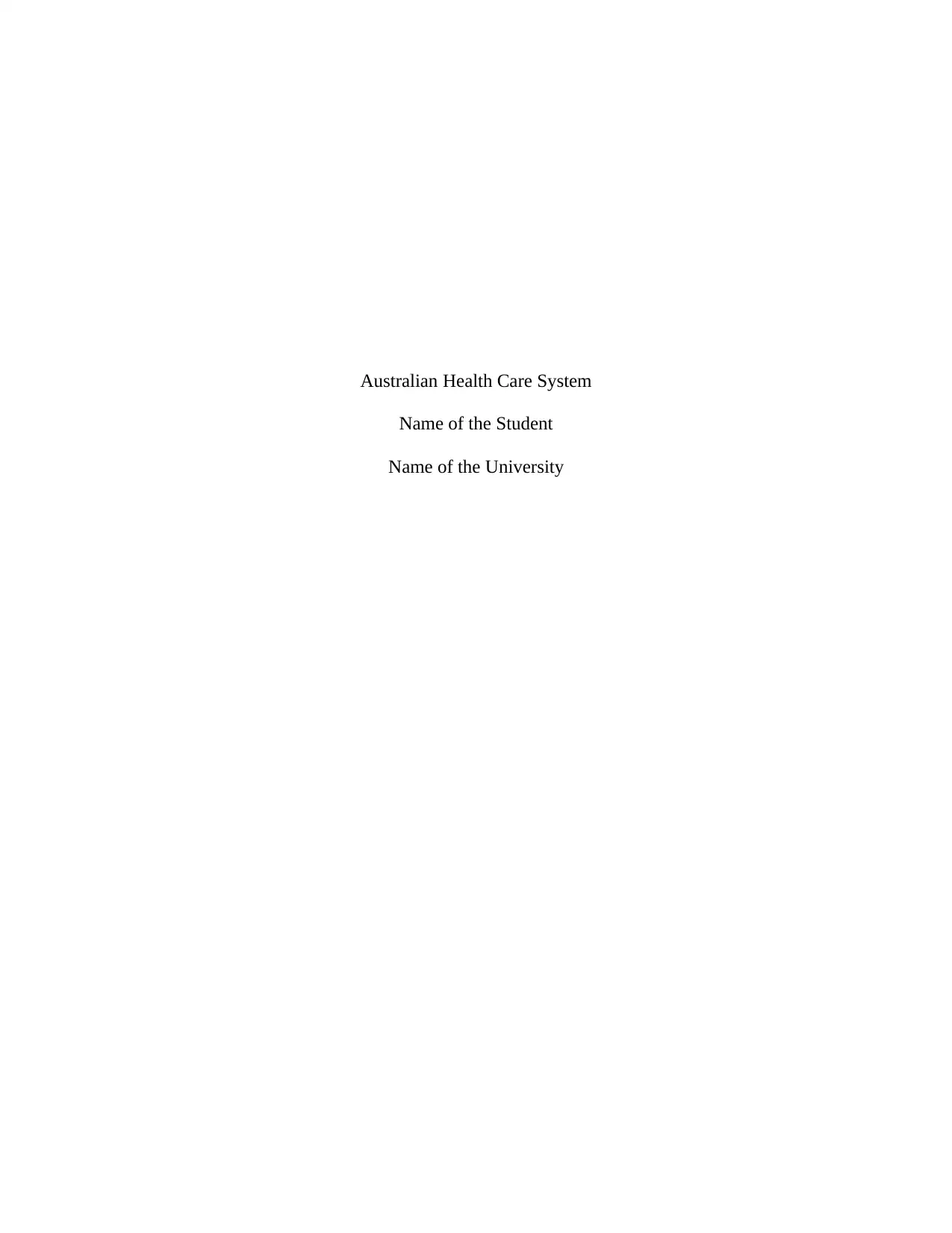
Australian Health Care System
Name of the Student
Name of the University
Name of the Student
Name of the University
Paraphrase This Document
Need a fresh take? Get an instant paraphrase of this document with our AI Paraphraser
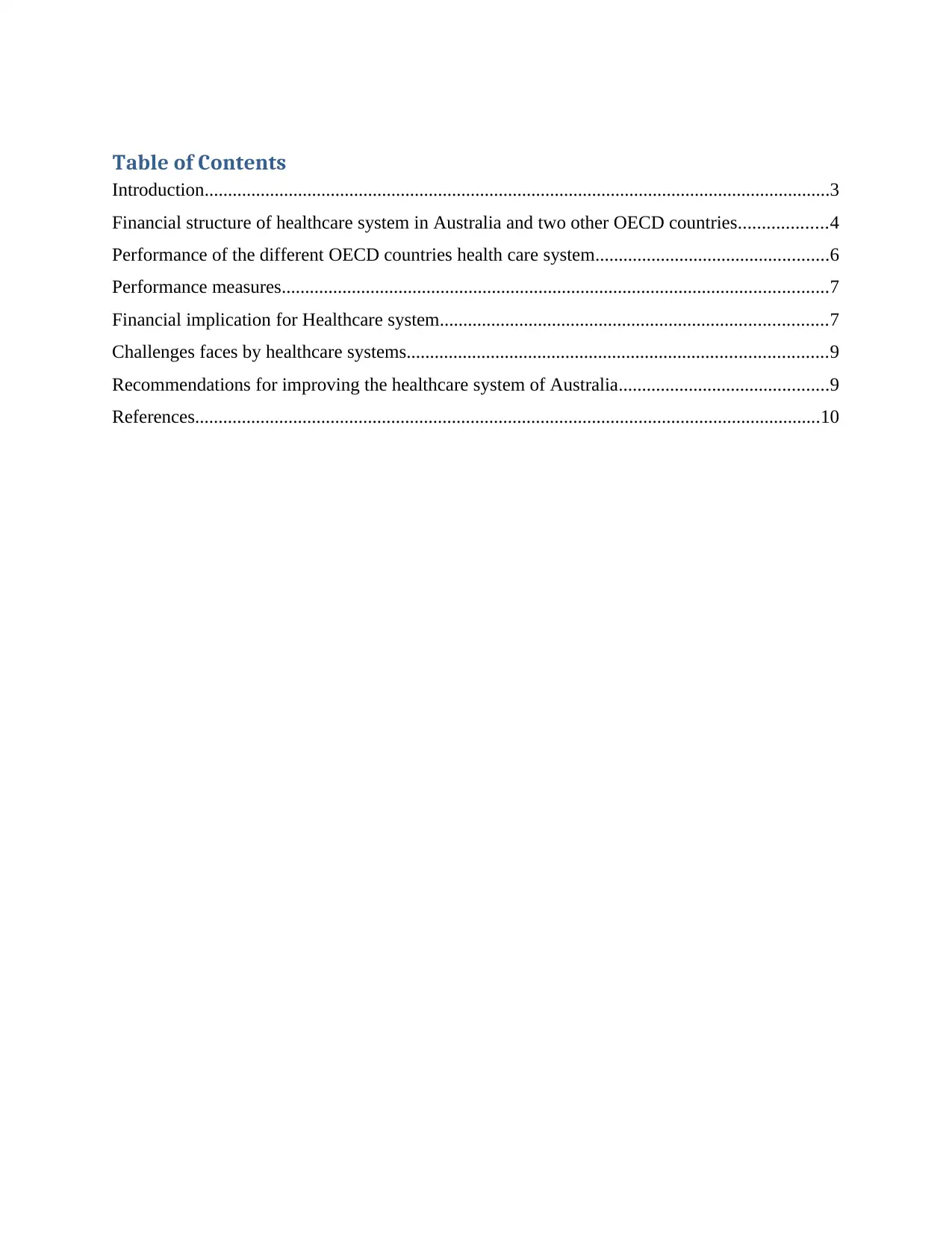
Table of Contents
Introduction......................................................................................................................................3
Financial structure of healthcare system in Australia and two other OECD countries...................4
Performance of the different OECD countries health care system..................................................6
Performance measures.....................................................................................................................7
Financial implication for Healthcare system...................................................................................7
Challenges faces by healthcare systems..........................................................................................9
Recommendations for improving the healthcare system of Australia.............................................9
References......................................................................................................................................10
Introduction......................................................................................................................................3
Financial structure of healthcare system in Australia and two other OECD countries...................4
Performance of the different OECD countries health care system..................................................6
Performance measures.....................................................................................................................7
Financial implication for Healthcare system...................................................................................7
Challenges faces by healthcare systems..........................................................................................9
Recommendations for improving the healthcare system of Australia.............................................9
References......................................................................................................................................10
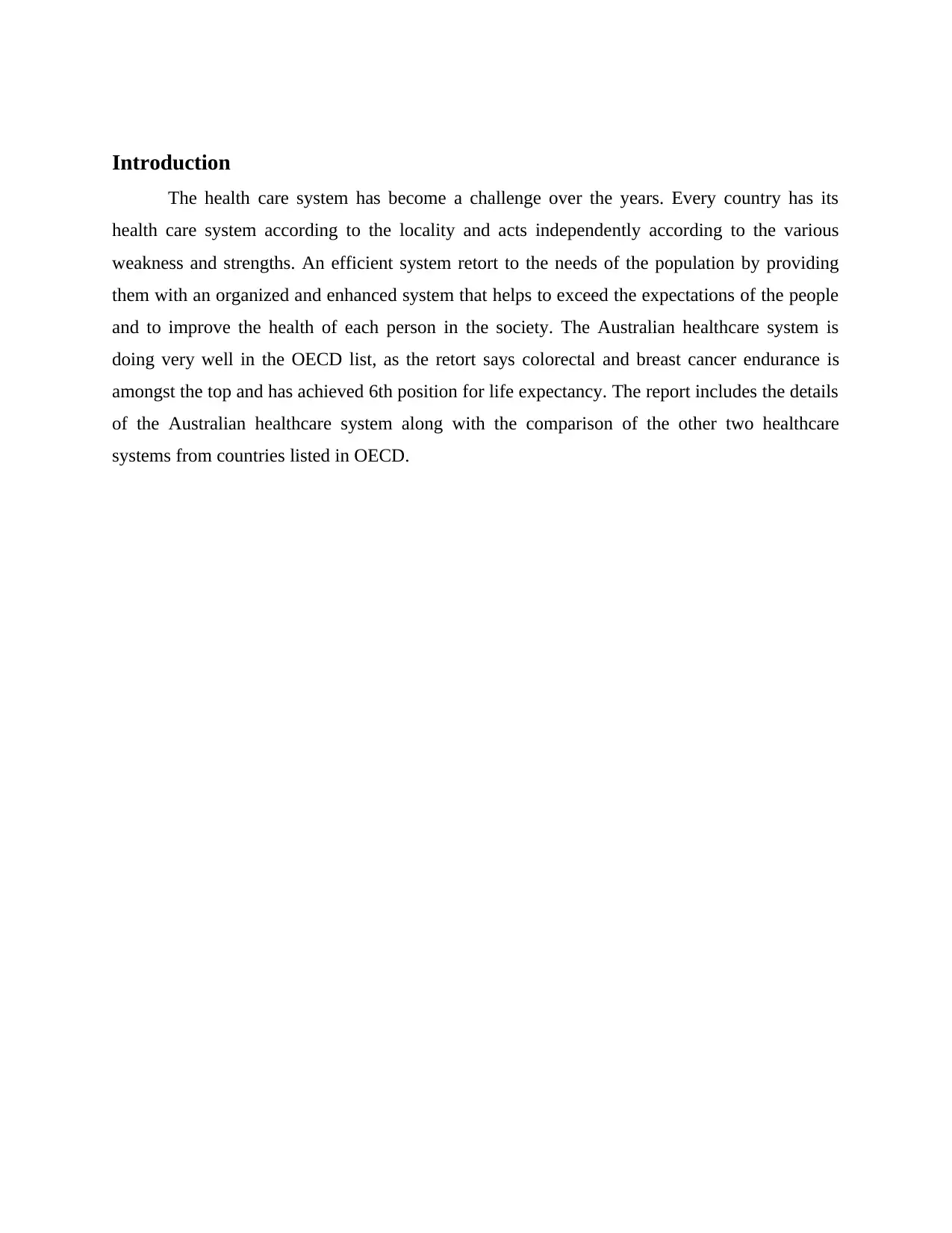
Introduction
The health care system has become a challenge over the years. Every country has its
health care system according to the locality and acts independently according to the various
weakness and strengths. An efficient system retort to the needs of the population by providing
them with an organized and enhanced system that helps to exceed the expectations of the people
and to improve the health of each person in the society. The Australian healthcare system is
doing very well in the OECD list, as the retort says colorectal and breast cancer endurance is
amongst the top and has achieved 6th position for life expectancy. The report includes the details
of the Australian healthcare system along with the comparison of the other two healthcare
systems from countries listed in OECD.
The health care system has become a challenge over the years. Every country has its
health care system according to the locality and acts independently according to the various
weakness and strengths. An efficient system retort to the needs of the population by providing
them with an organized and enhanced system that helps to exceed the expectations of the people
and to improve the health of each person in the society. The Australian healthcare system is
doing very well in the OECD list, as the retort says colorectal and breast cancer endurance is
amongst the top and has achieved 6th position for life expectancy. The report includes the details
of the Australian healthcare system along with the comparison of the other two healthcare
systems from countries listed in OECD.
⊘ This is a preview!⊘
Do you want full access?
Subscribe today to unlock all pages.

Trusted by 1+ million students worldwide
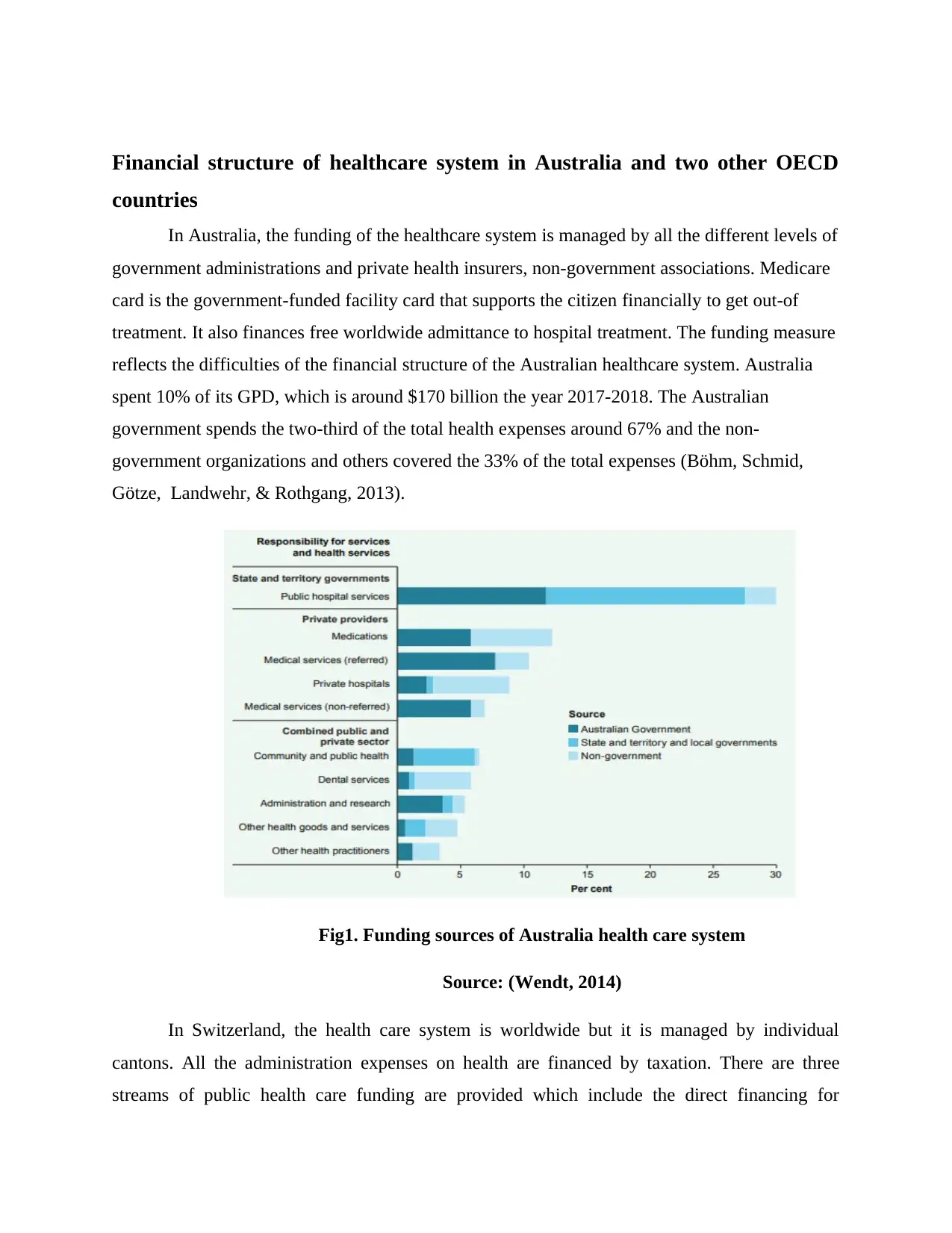
Financial structure of healthcare system in Australia and two other OECD
countries
In Australia, the funding of the healthcare system is managed by all the different levels of
government administrations and private health insurers, non-government associations. Medicare
card is the government-funded facility card that supports the citizen financially to get out-of
treatment. It also finances free worldwide admittance to hospital treatment. The funding measure
reflects the difficulties of the financial structure of the Australian healthcare system. Australia
spent 10% of its GPD, which is around $170 billion the year 2017-2018. The Australian
government spends the two-third of the total health expenses around 67% and the non-
government organizations and others covered the 33% of the total expenses (Böhm, Schmid,
Götze, Landwehr, & Rothgang, 2013).
Fig1. Funding sources of Australia health care system
Source: (Wendt, 2014)
In Switzerland, the health care system is worldwide but it is managed by individual
cantons. All the administration expenses on health are financed by taxation. There are three
streams of public health care funding are provided which include the direct financing for
countries
In Australia, the funding of the healthcare system is managed by all the different levels of
government administrations and private health insurers, non-government associations. Medicare
card is the government-funded facility card that supports the citizen financially to get out-of
treatment. It also finances free worldwide admittance to hospital treatment. The funding measure
reflects the difficulties of the financial structure of the Australian healthcare system. Australia
spent 10% of its GPD, which is around $170 billion the year 2017-2018. The Australian
government spends the two-third of the total health expenses around 67% and the non-
government organizations and others covered the 33% of the total expenses (Böhm, Schmid,
Götze, Landwehr, & Rothgang, 2013).
Fig1. Funding sources of Australia health care system
Source: (Wendt, 2014)
In Switzerland, the health care system is worldwide but it is managed by individual
cantons. All the administration expenses on health are financed by taxation. There are three
streams of public health care funding are provided which include the direct financing for
Paraphrase This Document
Need a fresh take? Get an instant paraphrase of this document with our AI Paraphraser
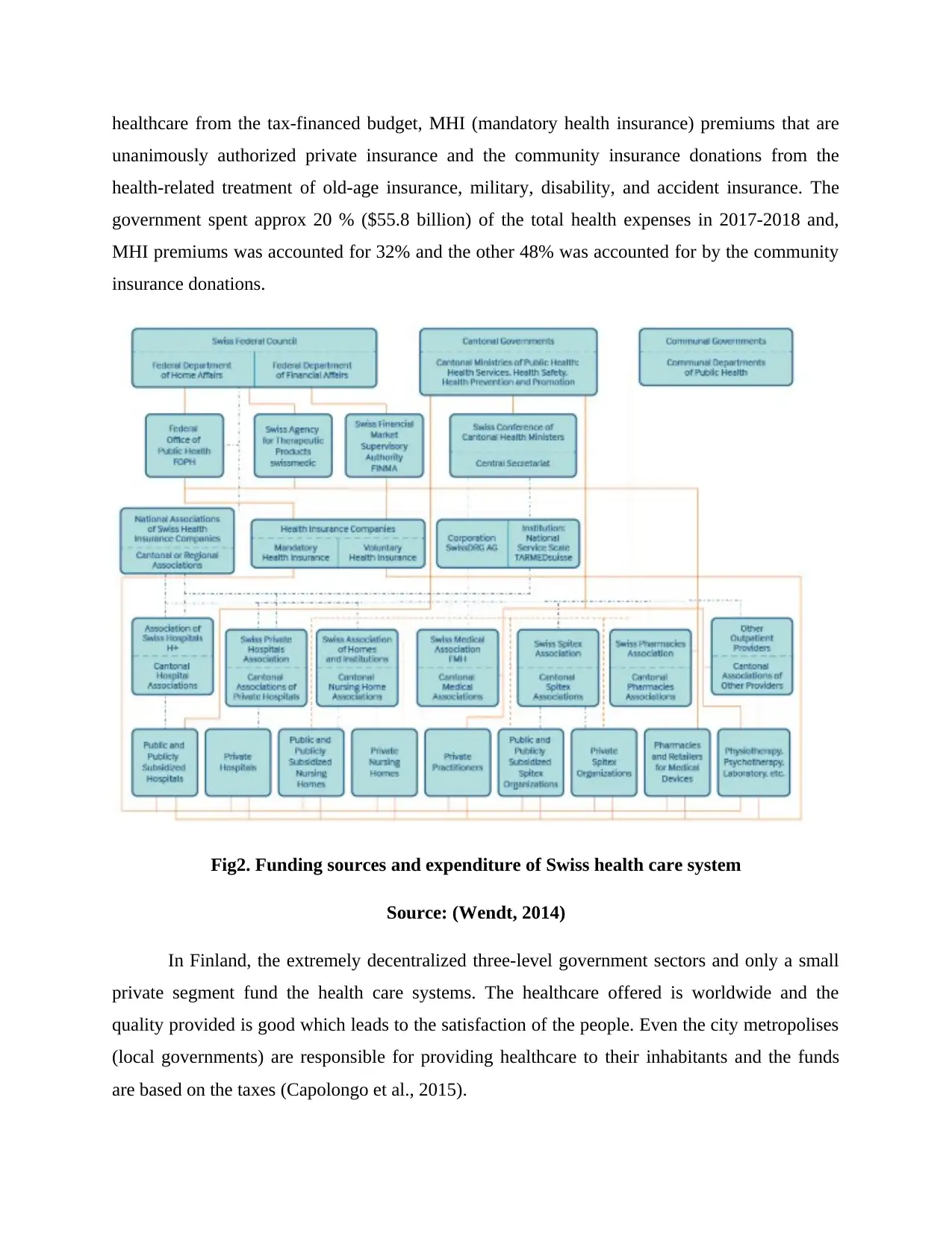
healthcare from the tax-financed budget, MHI (mandatory health insurance) premiums that are
unanimously authorized private insurance and the community insurance donations from the
health-related treatment of old-age insurance, military, disability, and accident insurance. The
government spent approx 20 % ($55.8 billion) of the total health expenses in 2017-2018 and,
MHI premiums was accounted for 32% and the other 48% was accounted for by the community
insurance donations.
Fig2. Funding sources and expenditure of Swiss health care system
Source: (Wendt, 2014)
In Finland, the extremely decentralized three-level government sectors and only a small
private segment fund the health care systems. The healthcare offered is worldwide and the
quality provided is good which leads to the satisfaction of the people. Even the city metropolises
(local governments) are responsible for providing healthcare to their inhabitants and the funds
are based on the taxes (Capolongo et al., 2015).
unanimously authorized private insurance and the community insurance donations from the
health-related treatment of old-age insurance, military, disability, and accident insurance. The
government spent approx 20 % ($55.8 billion) of the total health expenses in 2017-2018 and,
MHI premiums was accounted for 32% and the other 48% was accounted for by the community
insurance donations.
Fig2. Funding sources and expenditure of Swiss health care system
Source: (Wendt, 2014)
In Finland, the extremely decentralized three-level government sectors and only a small
private segment fund the health care systems. The healthcare offered is worldwide and the
quality provided is good which leads to the satisfaction of the people. Even the city metropolises
(local governments) are responsible for providing healthcare to their inhabitants and the funds
are based on the taxes (Capolongo et al., 2015).

⊘ This is a preview!⊘
Do you want full access?
Subscribe today to unlock all pages.

Trusted by 1+ million students worldwide
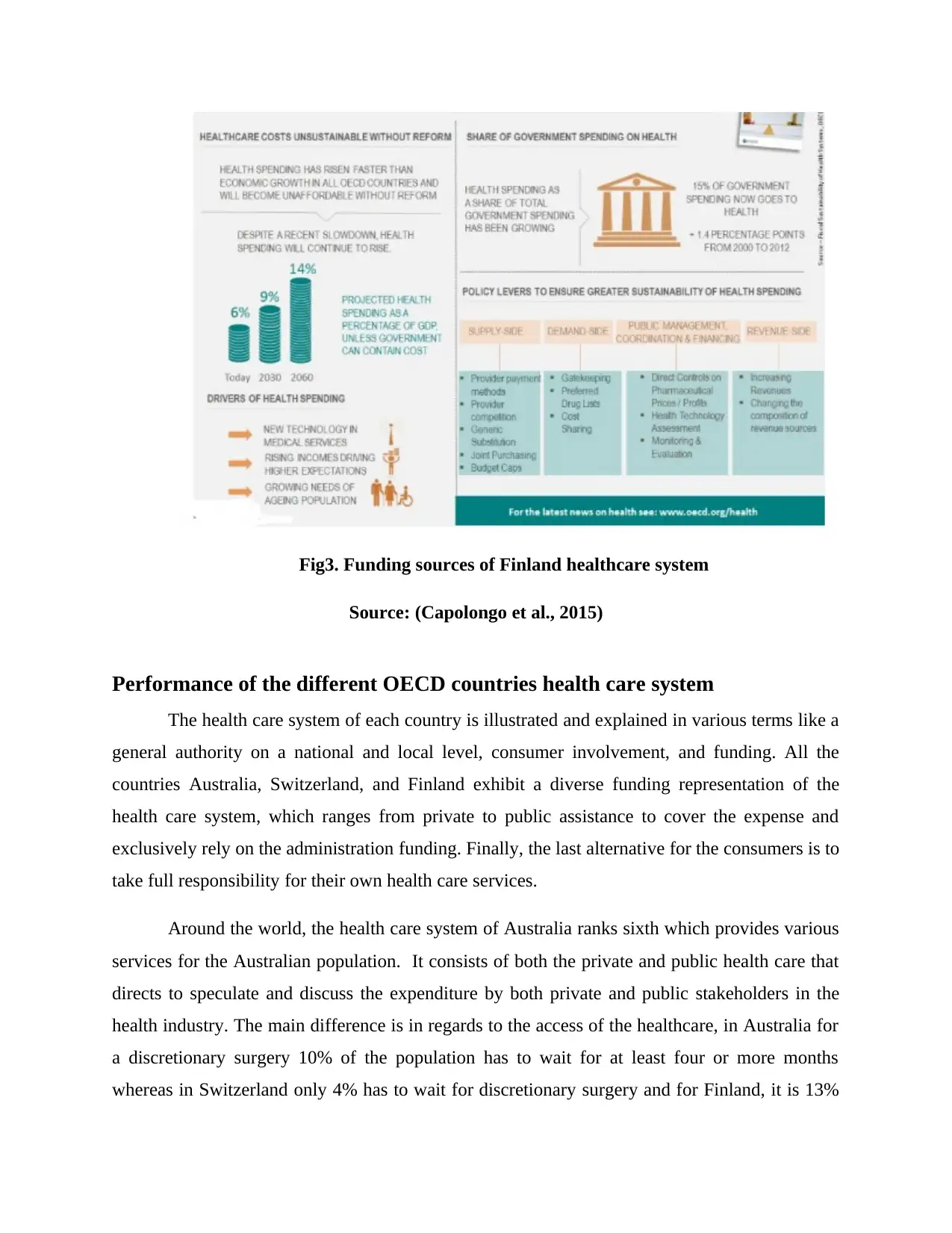
Fig3. Funding sources of Finland healthcare system
Source: (Capolongo et al., 2015)
Performance of the different OECD countries health care system
The health care system of each country is illustrated and explained in various terms like a
general authority on a national and local level, consumer involvement, and funding. All the
countries Australia, Switzerland, and Finland exhibit a diverse funding representation of the
health care system, which ranges from private to public assistance to cover the expense and
exclusively rely on the administration funding. Finally, the last alternative for the consumers is to
take full responsibility for their own health care services.
Around the world, the health care system of Australia ranks sixth which provides various
services for the Australian population. It consists of both the private and public health care that
directs to speculate and discuss the expenditure by both private and public stakeholders in the
health industry. The main difference is in regards to the access of the healthcare, in Australia for
a discretionary surgery 10% of the population has to wait for at least four or more months
whereas in Switzerland only 4% has to wait for discretionary surgery and for Finland, it is 13%
Source: (Capolongo et al., 2015)
Performance of the different OECD countries health care system
The health care system of each country is illustrated and explained in various terms like a
general authority on a national and local level, consumer involvement, and funding. All the
countries Australia, Switzerland, and Finland exhibit a diverse funding representation of the
health care system, which ranges from private to public assistance to cover the expense and
exclusively rely on the administration funding. Finally, the last alternative for the consumers is to
take full responsibility for their own health care services.
Around the world, the health care system of Australia ranks sixth which provides various
services for the Australian population. It consists of both the private and public health care that
directs to speculate and discuss the expenditure by both private and public stakeholders in the
health industry. The main difference is in regards to the access of the healthcare, in Australia for
a discretionary surgery 10% of the population has to wait for at least four or more months
whereas in Switzerland only 4% has to wait for discretionary surgery and for Finland, it is 13%
Paraphrase This Document
Need a fresh take? Get an instant paraphrase of this document with our AI Paraphraser
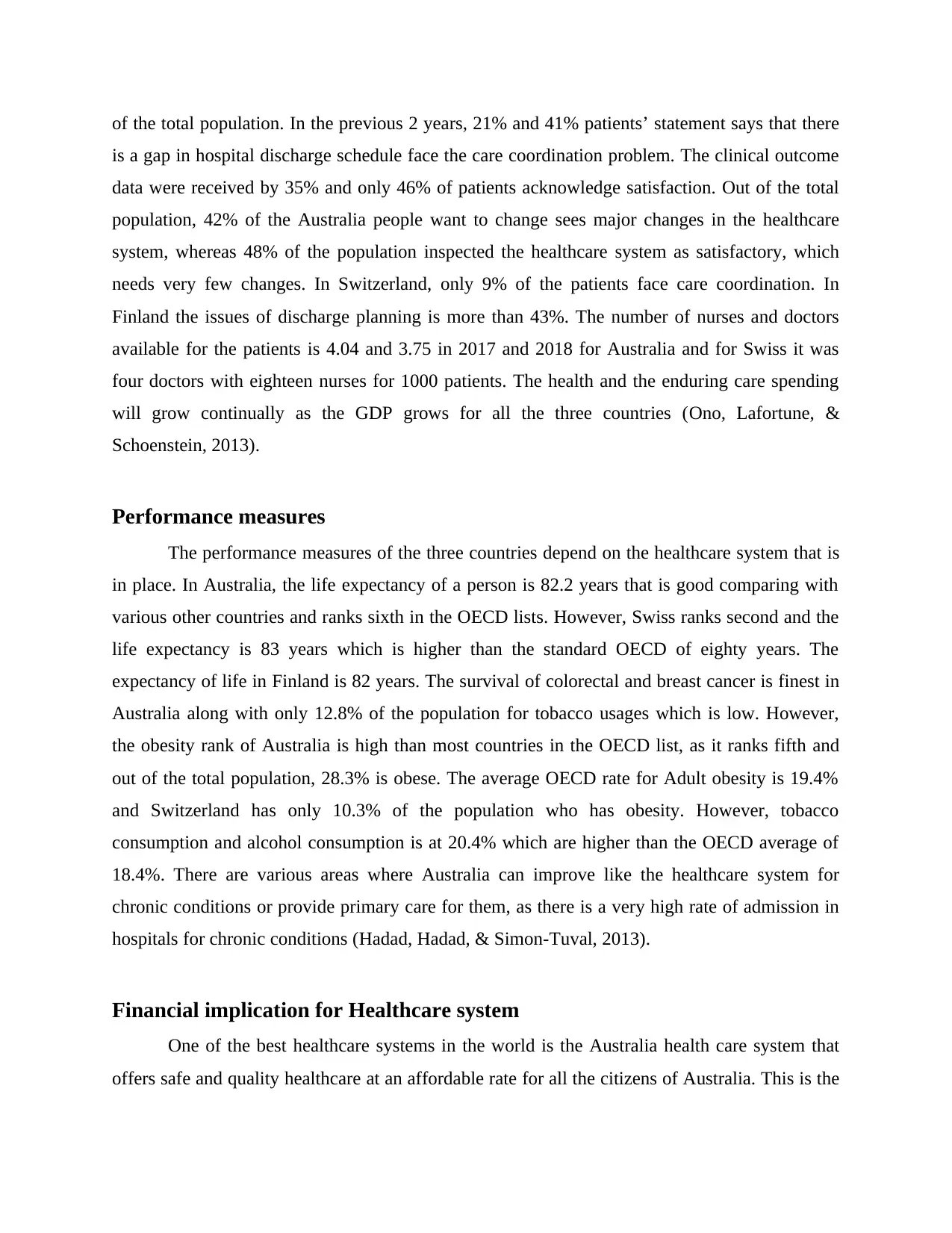
of the total population. In the previous 2 years, 21% and 41% patients’ statement says that there
is a gap in hospital discharge schedule face the care coordination problem. The clinical outcome
data were received by 35% and only 46% of patients acknowledge satisfaction. Out of the total
population, 42% of the Australia people want to change sees major changes in the healthcare
system, whereas 48% of the population inspected the healthcare system as satisfactory, which
needs very few changes. In Switzerland, only 9% of the patients face care coordination. In
Finland the issues of discharge planning is more than 43%. The number of nurses and doctors
available for the patients is 4.04 and 3.75 in 2017 and 2018 for Australia and for Swiss it was
four doctors with eighteen nurses for 1000 patients. The health and the enduring care spending
will grow continually as the GDP grows for all the three countries (Ono, Lafortune, &
Schoenstein, 2013).
Performance measures
The performance measures of the three countries depend on the healthcare system that is
in place. In Australia, the life expectancy of a person is 82.2 years that is good comparing with
various other countries and ranks sixth in the OECD lists. However, Swiss ranks second and the
life expectancy is 83 years which is higher than the standard OECD of eighty years. The
expectancy of life in Finland is 82 years. The survival of colorectal and breast cancer is finest in
Australia along with only 12.8% of the population for tobacco usages which is low. However,
the obesity rank of Australia is high than most countries in the OECD list, as it ranks fifth and
out of the total population, 28.3% is obese. The average OECD rate for Adult obesity is 19.4%
and Switzerland has only 10.3% of the population who has obesity. However, tobacco
consumption and alcohol consumption is at 20.4% which are higher than the OECD average of
18.4%. There are various areas where Australia can improve like the healthcare system for
chronic conditions or provide primary care for them, as there is a very high rate of admission in
hospitals for chronic conditions (Hadad, Hadad, & Simon-Tuval, 2013).
Financial implication for Healthcare system
One of the best healthcare systems in the world is the Australia health care system that
offers safe and quality healthcare at an affordable rate for all the citizens of Australia. This is the
is a gap in hospital discharge schedule face the care coordination problem. The clinical outcome
data were received by 35% and only 46% of patients acknowledge satisfaction. Out of the total
population, 42% of the Australia people want to change sees major changes in the healthcare
system, whereas 48% of the population inspected the healthcare system as satisfactory, which
needs very few changes. In Switzerland, only 9% of the patients face care coordination. In
Finland the issues of discharge planning is more than 43%. The number of nurses and doctors
available for the patients is 4.04 and 3.75 in 2017 and 2018 for Australia and for Swiss it was
four doctors with eighteen nurses for 1000 patients. The health and the enduring care spending
will grow continually as the GDP grows for all the three countries (Ono, Lafortune, &
Schoenstein, 2013).
Performance measures
The performance measures of the three countries depend on the healthcare system that is
in place. In Australia, the life expectancy of a person is 82.2 years that is good comparing with
various other countries and ranks sixth in the OECD lists. However, Swiss ranks second and the
life expectancy is 83 years which is higher than the standard OECD of eighty years. The
expectancy of life in Finland is 82 years. The survival of colorectal and breast cancer is finest in
Australia along with only 12.8% of the population for tobacco usages which is low. However,
the obesity rank of Australia is high than most countries in the OECD list, as it ranks fifth and
out of the total population, 28.3% is obese. The average OECD rate for Adult obesity is 19.4%
and Switzerland has only 10.3% of the population who has obesity. However, tobacco
consumption and alcohol consumption is at 20.4% which are higher than the OECD average of
18.4%. There are various areas where Australia can improve like the healthcare system for
chronic conditions or provide primary care for them, as there is a very high rate of admission in
hospitals for chronic conditions (Hadad, Hadad, & Simon-Tuval, 2013).
Financial implication for Healthcare system
One of the best healthcare systems in the world is the Australia health care system that
offers safe and quality healthcare at an affordable rate for all the citizens of Australia. This is the
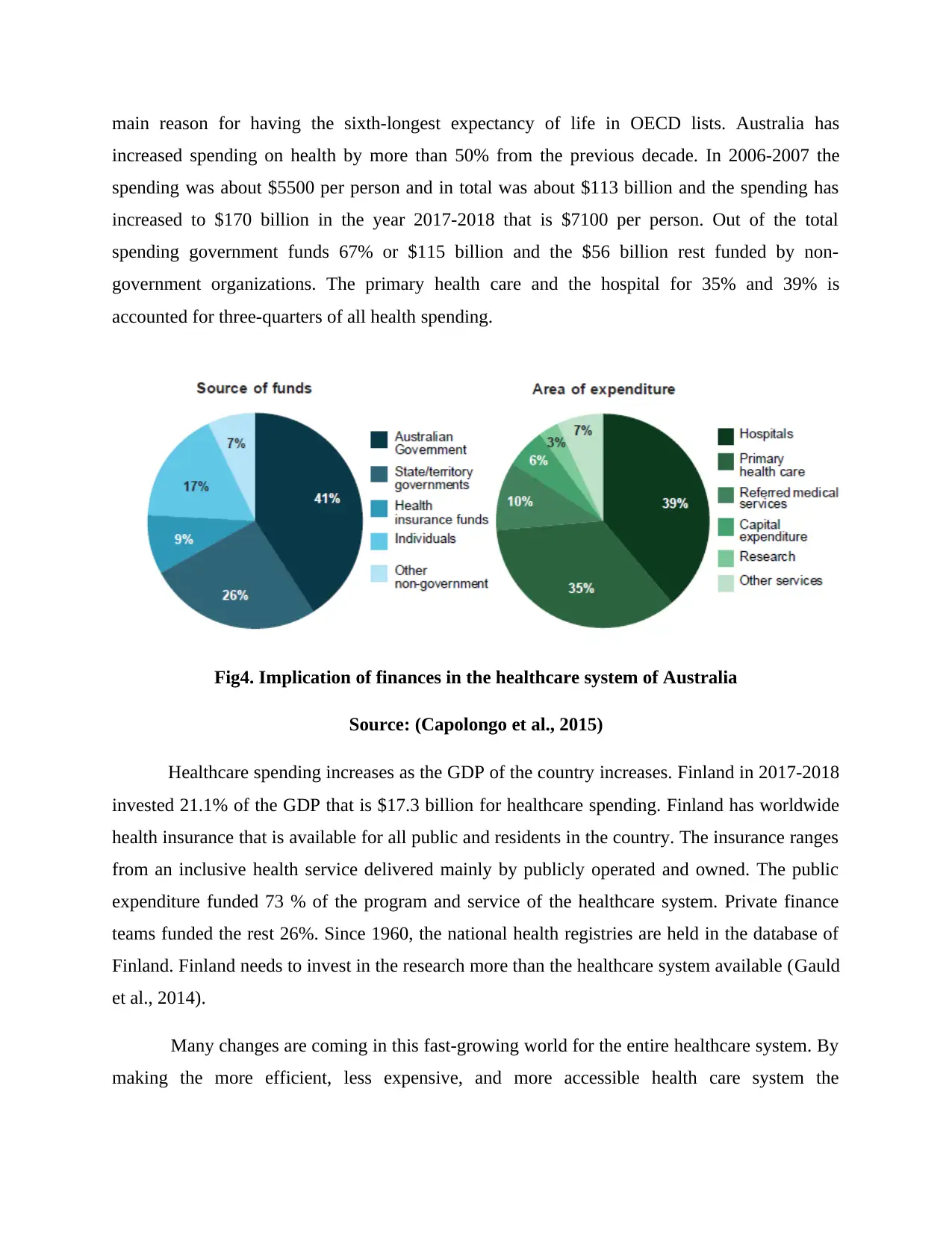
main reason for having the sixth-longest expectancy of life in OECD lists. Australia has
increased spending on health by more than 50% from the previous decade. In 2006-2007 the
spending was about $5500 per person and in total was about $113 billion and the spending has
increased to $170 billion in the year 2017-2018 that is $7100 per person. Out of the total
spending government funds 67% or $115 billion and the $56 billion rest funded by non-
government organizations. The primary health care and the hospital for 35% and 39% is
accounted for three-quarters of all health spending.
Fig4. Implication of finances in the healthcare system of Australia
Source: (Capolongo et al., 2015)
Healthcare spending increases as the GDP of the country increases. Finland in 2017-2018
invested 21.1% of the GDP that is $17.3 billion for healthcare spending. Finland has worldwide
health insurance that is available for all public and residents in the country. The insurance ranges
from an inclusive health service delivered mainly by publicly operated and owned. The public
expenditure funded 73 % of the program and service of the healthcare system. Private finance
teams funded the rest 26%. Since 1960, the national health registries are held in the database of
Finland. Finland needs to invest in the research more than the healthcare system available (Gauld
et al., 2014).
Many changes are coming in this fast-growing world for the entire healthcare system. By
making the more efficient, less expensive, and more accessible health care system the
increased spending on health by more than 50% from the previous decade. In 2006-2007 the
spending was about $5500 per person and in total was about $113 billion and the spending has
increased to $170 billion in the year 2017-2018 that is $7100 per person. Out of the total
spending government funds 67% or $115 billion and the $56 billion rest funded by non-
government organizations. The primary health care and the hospital for 35% and 39% is
accounted for three-quarters of all health spending.
Fig4. Implication of finances in the healthcare system of Australia
Source: (Capolongo et al., 2015)
Healthcare spending increases as the GDP of the country increases. Finland in 2017-2018
invested 21.1% of the GDP that is $17.3 billion for healthcare spending. Finland has worldwide
health insurance that is available for all public and residents in the country. The insurance ranges
from an inclusive health service delivered mainly by publicly operated and owned. The public
expenditure funded 73 % of the program and service of the healthcare system. Private finance
teams funded the rest 26%. Since 1960, the national health registries are held in the database of
Finland. Finland needs to invest in the research more than the healthcare system available (Gauld
et al., 2014).
Many changes are coming in this fast-growing world for the entire healthcare system. By
making the more efficient, less expensive, and more accessible health care system the
⊘ This is a preview!⊘
Do you want full access?
Subscribe today to unlock all pages.

Trusted by 1+ million students worldwide
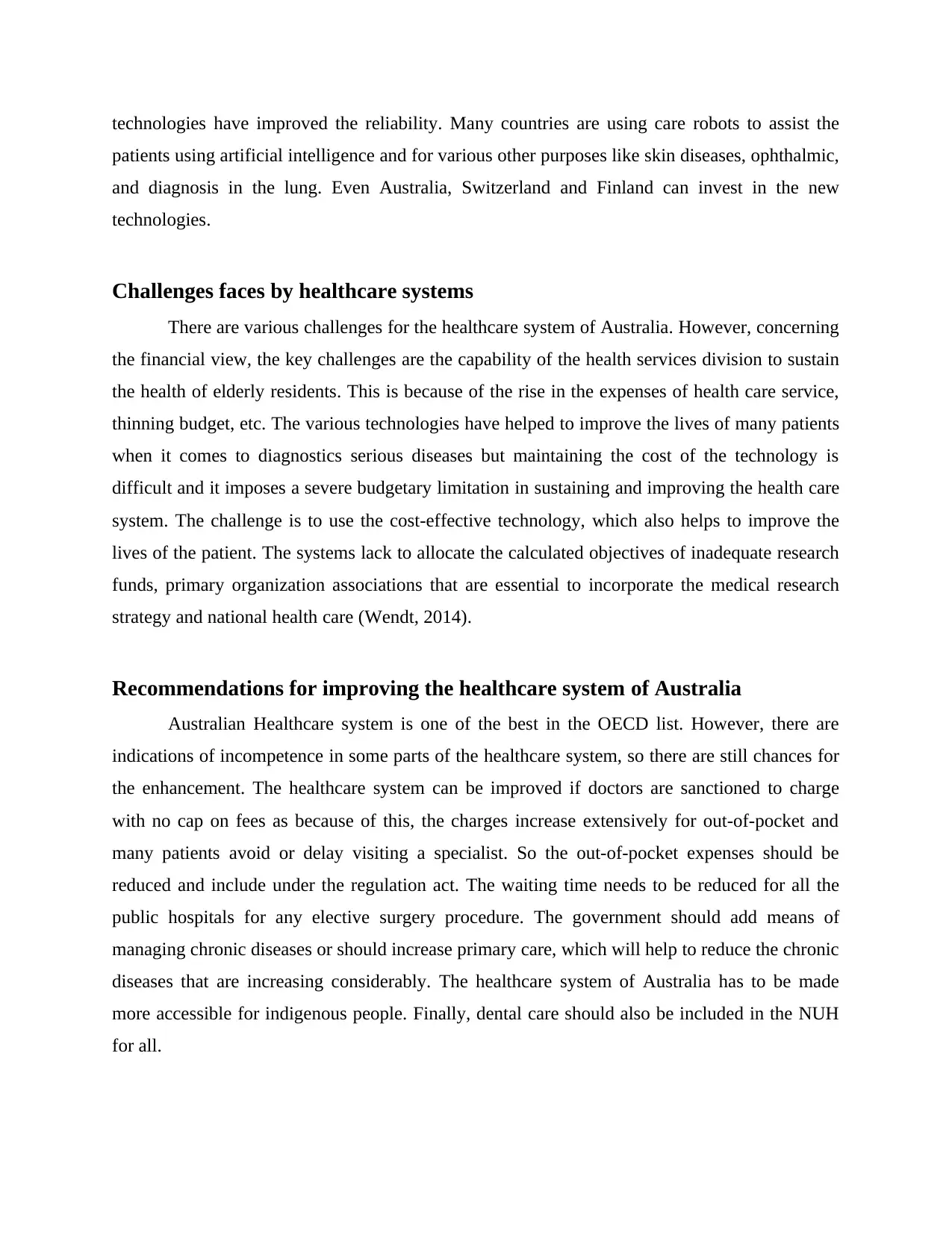
technologies have improved the reliability. Many countries are using care robots to assist the
patients using artificial intelligence and for various other purposes like skin diseases, ophthalmic,
and diagnosis in the lung. Even Australia, Switzerland and Finland can invest in the new
technologies.
Challenges faces by healthcare systems
There are various challenges for the healthcare system of Australia. However, concerning
the financial view, the key challenges are the capability of the health services division to sustain
the health of elderly residents. This is because of the rise in the expenses of health care service,
thinning budget, etc. The various technologies have helped to improve the lives of many patients
when it comes to diagnostics serious diseases but maintaining the cost of the technology is
difficult and it imposes a severe budgetary limitation in sustaining and improving the health care
system. The challenge is to use the cost-effective technology, which also helps to improve the
lives of the patient. The systems lack to allocate the calculated objectives of inadequate research
funds, primary organization associations that are essential to incorporate the medical research
strategy and national health care (Wendt, 2014).
Recommendations for improving the healthcare system of Australia
Australian Healthcare system is one of the best in the OECD list. However, there are
indications of incompetence in some parts of the healthcare system, so there are still chances for
the enhancement. The healthcare system can be improved if doctors are sanctioned to charge
with no cap on fees as because of this, the charges increase extensively for out-of-pocket and
many patients avoid or delay visiting a specialist. So the out-of-pocket expenses should be
reduced and include under the regulation act. The waiting time needs to be reduced for all the
public hospitals for any elective surgery procedure. The government should add means of
managing chronic diseases or should increase primary care, which will help to reduce the chronic
diseases that are increasing considerably. The healthcare system of Australia has to be made
more accessible for indigenous people. Finally, dental care should also be included in the NUH
for all.
patients using artificial intelligence and for various other purposes like skin diseases, ophthalmic,
and diagnosis in the lung. Even Australia, Switzerland and Finland can invest in the new
technologies.
Challenges faces by healthcare systems
There are various challenges for the healthcare system of Australia. However, concerning
the financial view, the key challenges are the capability of the health services division to sustain
the health of elderly residents. This is because of the rise in the expenses of health care service,
thinning budget, etc. The various technologies have helped to improve the lives of many patients
when it comes to diagnostics serious diseases but maintaining the cost of the technology is
difficult and it imposes a severe budgetary limitation in sustaining and improving the health care
system. The challenge is to use the cost-effective technology, which also helps to improve the
lives of the patient. The systems lack to allocate the calculated objectives of inadequate research
funds, primary organization associations that are essential to incorporate the medical research
strategy and national health care (Wendt, 2014).
Recommendations for improving the healthcare system of Australia
Australian Healthcare system is one of the best in the OECD list. However, there are
indications of incompetence in some parts of the healthcare system, so there are still chances for
the enhancement. The healthcare system can be improved if doctors are sanctioned to charge
with no cap on fees as because of this, the charges increase extensively for out-of-pocket and
many patients avoid or delay visiting a specialist. So the out-of-pocket expenses should be
reduced and include under the regulation act. The waiting time needs to be reduced for all the
public hospitals for any elective surgery procedure. The government should add means of
managing chronic diseases or should increase primary care, which will help to reduce the chronic
diseases that are increasing considerably. The healthcare system of Australia has to be made
more accessible for indigenous people. Finally, dental care should also be included in the NUH
for all.
Paraphrase This Document
Need a fresh take? Get an instant paraphrase of this document with our AI Paraphraser
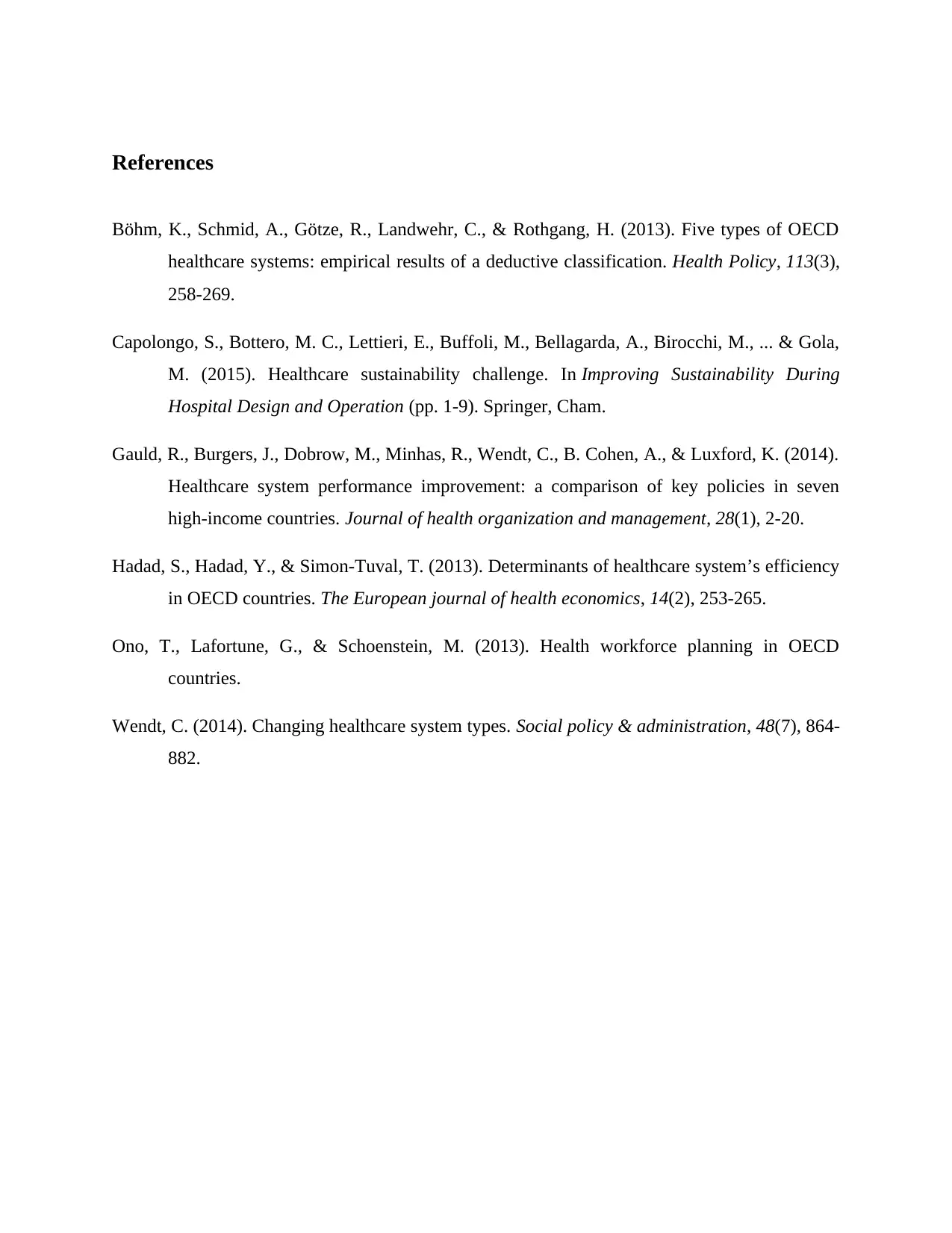
References
Böhm, K., Schmid, A., Götze, R., Landwehr, C., & Rothgang, H. (2013). Five types of OECD
healthcare systems: empirical results of a deductive classification. Health Policy, 113(3),
258-269.
Capolongo, S., Bottero, M. C., Lettieri, E., Buffoli, M., Bellagarda, A., Birocchi, M., ... & Gola,
M. (2015). Healthcare sustainability challenge. In Improving Sustainability During
Hospital Design and Operation (pp. 1-9). Springer, Cham.
Gauld, R., Burgers, J., Dobrow, M., Minhas, R., Wendt, C., B. Cohen, A., & Luxford, K. (2014).
Healthcare system performance improvement: a comparison of key policies in seven
high-income countries. Journal of health organization and management, 28(1), 2-20.
Hadad, S., Hadad, Y., & Simon-Tuval, T. (2013). Determinants of healthcare system’s efficiency
in OECD countries. The European journal of health economics, 14(2), 253-265.
Ono, T., Lafortune, G., & Schoenstein, M. (2013). Health workforce planning in OECD
countries.
Wendt, C. (2014). Changing healthcare system types. Social policy & administration, 48(7), 864-
882.
Böhm, K., Schmid, A., Götze, R., Landwehr, C., & Rothgang, H. (2013). Five types of OECD
healthcare systems: empirical results of a deductive classification. Health Policy, 113(3),
258-269.
Capolongo, S., Bottero, M. C., Lettieri, E., Buffoli, M., Bellagarda, A., Birocchi, M., ... & Gola,
M. (2015). Healthcare sustainability challenge. In Improving Sustainability During
Hospital Design and Operation (pp. 1-9). Springer, Cham.
Gauld, R., Burgers, J., Dobrow, M., Minhas, R., Wendt, C., B. Cohen, A., & Luxford, K. (2014).
Healthcare system performance improvement: a comparison of key policies in seven
high-income countries. Journal of health organization and management, 28(1), 2-20.
Hadad, S., Hadad, Y., & Simon-Tuval, T. (2013). Determinants of healthcare system’s efficiency
in OECD countries. The European journal of health economics, 14(2), 253-265.
Ono, T., Lafortune, G., & Schoenstein, M. (2013). Health workforce planning in OECD
countries.
Wendt, C. (2014). Changing healthcare system types. Social policy & administration, 48(7), 864-
882.
1 out of 11
Related Documents
Your All-in-One AI-Powered Toolkit for Academic Success.
+13062052269
info@desklib.com
Available 24*7 on WhatsApp / Email
![[object Object]](/_next/static/media/star-bottom.7253800d.svg)
Unlock your academic potential
Copyright © 2020–2025 A2Z Services. All Rights Reserved. Developed and managed by ZUCOL.





